Laser Ablation of NiFe2O4 and CoFe2O4 Nanoparticles
Abstract
:1. Introduction
2. Materials and Methods
2.1. Sample Preparation
2.2. Laser Ablation
2.3. Analytic Methods
3. Results
3.1. Optimization of Laser Ablation Parameters
3.2. Material Structure Analysis
3.3. Mössbauer Spectroscopy
3.4. Magnetic Measurements
3.5. Light Absorption Behavior
3.6. High-Gradient Magnetic Separation (HGMS)
4. Discussion
Supplementary Materials
Author Contributions
Funding
Institutional Review Board Statement
Informed Consent Statement
Data Availability Statement
Acknowledgments
Conflicts of Interest
References
- Gökce, B.; Amendola, V.; Barcikowski, S. Opportunities and Challenges for Laser Synthesis of Colloids. Chem. Phys. Chem. 2017, 18, 983–985. [Google Scholar] [CrossRef] [PubMed] [Green Version]
- Zhang, D.; Gökce, B.; Barcikowski, S. Laser Synthesis and Processing of Colloids: Fundamentals and Applications. Chem. Rev. 2017, 117, 3990–4103. [Google Scholar] [CrossRef] [PubMed]
- Tsuji, T.; Hamagami, T.; Kawamura, T.; Yamaki, J.; Tsuji, M. Laser ablation of cobalt and cobalt oxides in liquids: Influence of solvent on composition of prepared nanoparticles. Appl. Surf. Sci. 2005, 243, 214–219. [Google Scholar] [CrossRef]
- Tsuji, T.; Tatsuyama, Y.; Tsuji, M.; Ishida, K.; Okada, S.; Yamaki, J. Preparation of LiMn2O4 nanoparticles for Li ion secondary batteries by laser ablation in water. Mater. Lett. 2007, 61, 2062–2065. [Google Scholar] [CrossRef]
- Relvas, M.S.; Soares, M.R.N.; Pereira, S.O.; Girão, A.V.; Costa, F.M.; Monteiro, T. Trends in Cr3+ red emissions from ZnGa2O4 nanostructures produced by pulsed laser ablation in a liquid medium. J. Phys. Chem. Solids 2019, 129, 413–423. [Google Scholar] [CrossRef]
- Du, H.; Castaing, V.; Guo, D.; Viana, B. SrAl2O4:Eu2+, Dy3+ doped-nanoparticles prepared by pulsed laser ablation in liquids. In Oxide-Based Materials and Devices XI; International Society for Optics and Photonics: Bellingham, WA, USA, 2020; pp. 170–177. [Google Scholar] [CrossRef]
- Gopal, R.; Singh, S.C.; Swarnkar, R.K. Nickel ferrite nanomaterials by pulsed laser ablation in water; structural, optical and magnetic characterizations. In Proceedings of the Nanotech Conference & Expo 2009, NSTI-Nanotech, Houston, TX, USA, 3–7 May 2009. [Google Scholar]
- Özçelik, S.; Yalçın, B.; Arda, L.; Santos, H.; Sáez-Puche, R.; Angurel, L.A.; de la Fuente, G.F.; Özçelik, B. Structure, magnetic, photocatalytic and blood compatibility studies of nickel nanoferrites prepared by laser ablation technique in distilled water. J. Alloys Compd. 2021, 854, 157279. [Google Scholar] [CrossRef]
- Bulai, G.; Dumitru, I.; Pinteala, M.; Focsa, C.; Gurlui, S. Magnetic nanoparticles generated by laser ablation in liquid. Dig. J. Nanomater. Biostruct. 2016, 11, 283–291. [Google Scholar]
- Chan, Y.-T.; Wu, C.-H.; Shen, P.; Chen, S.-Y. Nickel aluminate oxides/hydroxides by pulsed laser ablation of NiAl2O4 powder in water. Appl. Phys. A Mater. Sci. Process. 2014, 116, 1065–1073. [Google Scholar] [CrossRef]
- Waag, F.; Gökce, B.; Kalapu, C.; Bendt, G.; Salamon, S.; Landers, J.; Hagemann, U.; Heidelmann, M.; Schulz, S.; Wende, H.; et al. Adjusting the catalytic properties of cobalt ferrite nanoparticles by pulsed laser fragmentation in water with defined energy dose. Sci. Rep. 2017, 7, 13161. [Google Scholar] [CrossRef] [Green Version]
- Siebeneicher, S.; Waag, F.; Escobar Castillo, M.; Shvartsman, V.V.; Lupascu, D.C.; Gökce, B. Laser Fragmentation Synthesis of Colloidal Bismuth Ferrite Particles. Nanomaterials 2020, 10, 359. [Google Scholar] [CrossRef] [PubMed] [Green Version]
- Iraqui, S.; Kashyap, S.S.; Rashid, H. NiFe2O4 nanoparticles: An efficient and reusable catalyst for the selective oxidation of benzyl alcohol to benzaldehyde under mild conditions. Nanoscale Adv. 2020, 2, 5790. [Google Scholar] [CrossRef]
- Li, P.; Li, Z.; Zhai, F.; Wan, Q.; Li, X.; Qu, X.; Volinsky, A.A. NiFe2O4 Nanoparticles Catalytic Effects of Improving LiAlH4 Dehydrogenation Properties. J. Phys. Chem. C 2013, 117, 25917–25925. [Google Scholar] [CrossRef] [Green Version]
- Peng, T.; Zhang, X.; Lv, H.; Zan, L. Preparation of NiFe2O4 nanoparticles and its visible-light-driven photoactivity for hydrogen production. Catal. Commun. 2012, 28, 116–119. [Google Scholar] [CrossRef]
- Liu, S.; He, F.; Huang, Z.; Zheng, A.; Feng, Y.; Shen, Y.; Li, H.; Wu, H.; Glarborg, P. Screening of NiFe2O4 Nanoparticles as Oxygen Carrier in Chemical Looping Hydrogen Production. Energy Fuels 2016, 30, 4251–4262. [Google Scholar] [CrossRef]
- Ferreira, M.; Sousa, J.; Pais, A.; Vitorino, C. The Role of Magnetic Nanoparticles in Cancer Nanotheranostics. Materials 2020, 13, 266. [Google Scholar] [CrossRef] [PubMed] [Green Version]
- Irfan, M.; Dogan, N.; Bingolbali, A.; Aliew, F. Synthesis and characterization of NiFe2O4 magnetic nanoparticles with different coating materials for magnetic particle imaging (MPI). J. Magn. Magn. Mater. 2021, 537, 168150. [Google Scholar] [CrossRef]
- Joshy, K.S.; Augustine, R.; Mayeen, A.; Alex, S.M.; Hasan, A.; Thomas, S.; Chi, H. NiFe2O4/poly(ethylene glycol)/lipid–polymer hybrid nanoparticles for anti-cancer drug delivery. New J. Chem. 2020, 44, 18162–18172. [Google Scholar] [CrossRef]
- Saykova, D.; Saikova, S.; Mikhlin, Y.; Panteleeva, M.; Ivantsov, R.; Belova, E. Synthesis and Characterization of Core–Shell Magnetic Nanoparticles NiFe2O4@Au. Metals 2020, 10, 1075. [Google Scholar] [CrossRef]
- Rehbock, C.; Jakobi, J.; Gamrad, L.; van der Meer, S.; Tiedemann, D.; Taylor, U.; Kues, W.; Rath, D.; Barcikowski, S. Current state of laser synthesis of metal and alloy nanoparticles as ligand-free reference materials for nano-toxicological assays. Beilstein J. Nanotechnol. 2014, 5, 1523–1541. [Google Scholar] [CrossRef]
- Nichols, W.T.; Sasaki, T.; Koshizaki, N. Laser ablation of a platinum target in water. II. Ablation rate and nanoparticle size distributions. J. Appl. Phys. 2006, 100, 114912. [Google Scholar] [CrossRef]
- Kumar, N.; Archana; Singh, R.K.; Kumar, V.; Das, S.B. Tuning in structural, optoelectronic, magnetic and ferroelectric properties of NiFe2O4 ceramics engineering nanomaterials by substitution of rare earth element, Pr3+ prepared by sol–gel method. J. Mater. Sci. Mater. Electron. 2022, 33, 6131–6149. [Google Scholar] [CrossRef]
- Guntlin, C.P.; Ochsenbein, S.T.; Wörle, M.; Erni, R.; Kravchyk, K.V.; Kovalenko, M.V. Popcorn-Shaped FexO (Wüstite) Nanoparticles from a Single-Source Precursor: Colloidal Synthesis and Magnetic Properties. Chem. Mater. 2018, 30, 1249–1256. [Google Scholar] [CrossRef] [PubMed] [Green Version]
- Landers, J.; Salamon, S.; Webers, S.; Wende, H. Microscopic understanding of particle-matrix interaction in magnetic hybrid materials by elements-specific spectroscopy. Phys. Sci. Rev. 2021, 20190116. [Google Scholar] [CrossRef]
- Yavuz, C.T.; Mayo, J.T.; Yu, W.W.; Prakash, A.; Falkner, J.C.; Yean, S.; Cong, L.; Shipley, H.J.; Kan, A.; Tomson, M.; et al. Low-field magnetic separation of Monodisperse Fe3O4 nanocrystals. Science 2006, 314, 964–967. [Google Scholar] [CrossRef]
- García, P.F.; Brammen, M.; Wolf, M.; Reinlein, S.; von Roman, M.F.; Berensmeier, S. High-gradient magnetic separation for technical scale protein recovery using low cost magnetic nanoparticles. Sep. Purif. Technol. 2015, 150, 29–36. [Google Scholar] [CrossRef]
- Furlong, D.N.; Launikonis, A.; Sasse, W.H.; Sanders, J.V. Colloidal platinum sols. Preparation, characterization and stability towards salt. J. Chem. Soc. Faraday Trans. 1 Phys. Chem. Condens. Phases 1984, 80, 571–588. [Google Scholar] [CrossRef]
- Khan, M.A.; Al-Oufi, M.; Tossef, A.; Al-Salik, Y.; Idriss, H. On the role of CoO in CoOx/TiO2 for the photocatalytic hydrogen production from water in the presence of glycerol. Catal. Struct. React. 2015, 1, 192–200. [Google Scholar] [CrossRef]
- Townsend, T.; Browning, N.; Osterloh, F. Overall photocatalytic water splitting with NiO x-SrTiO 3—A revised mechanism. Energy Environ. Sci. 2012, 5, 9543–9550. [Google Scholar] [CrossRef]
- Kato, H.; Asakura, K.; Kudo, A. Highly efficient water splitting into H2 and O2 over lanthanum-doped NaTaO3 photocatalysts with high crystallinity and surface nanostructure. J. Am. Chem. Soc. 2003, 125, 3082–3089. [Google Scholar] [CrossRef]
- Liu, G.; Gao, X.; Wang, K.; He, D.; Li, J. Uniformly mesoporous NiO/NiFe2O4 biphasic nanorods as efficient oxygen evolving catalyst for water splitting. Int. J. Hydrogen Energy 2016, 41, 17976–17986. [Google Scholar] [CrossRef]
- Sepideh, S.; Gholamreza, N.; Farhad, H. A short time microwave method for synthesis of magnetic NiFe2O4/NiO nanocomposites as a clean technology in photocatalytic degradation of water pollutants. J. Mater. Sci. Mater. Electron. 2019, 30, 8171–8181. [Google Scholar] [CrossRef]
- Shen, S.; Wang, Z.; Lin, Z.; Song, K.; Zhang, Q.; Meng, F.; Gu, L.; Zhong, W. Crystalline-Amorphous Interfaces Coupling of CoS2/CoP with Optimized D-Band Center and Boosted Electrocatalytic Hydrogen Evolution. Adv. Mater. 2022, 34, 2110631. [Google Scholar] [CrossRef] [PubMed]
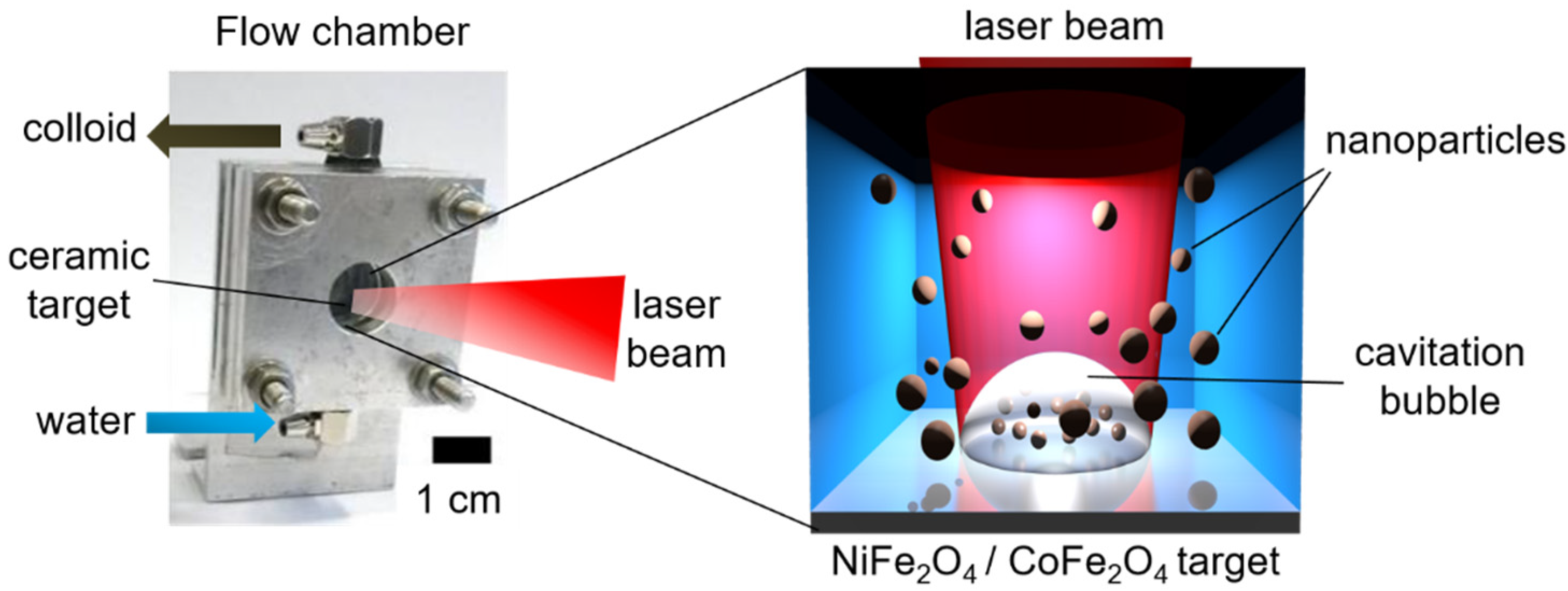
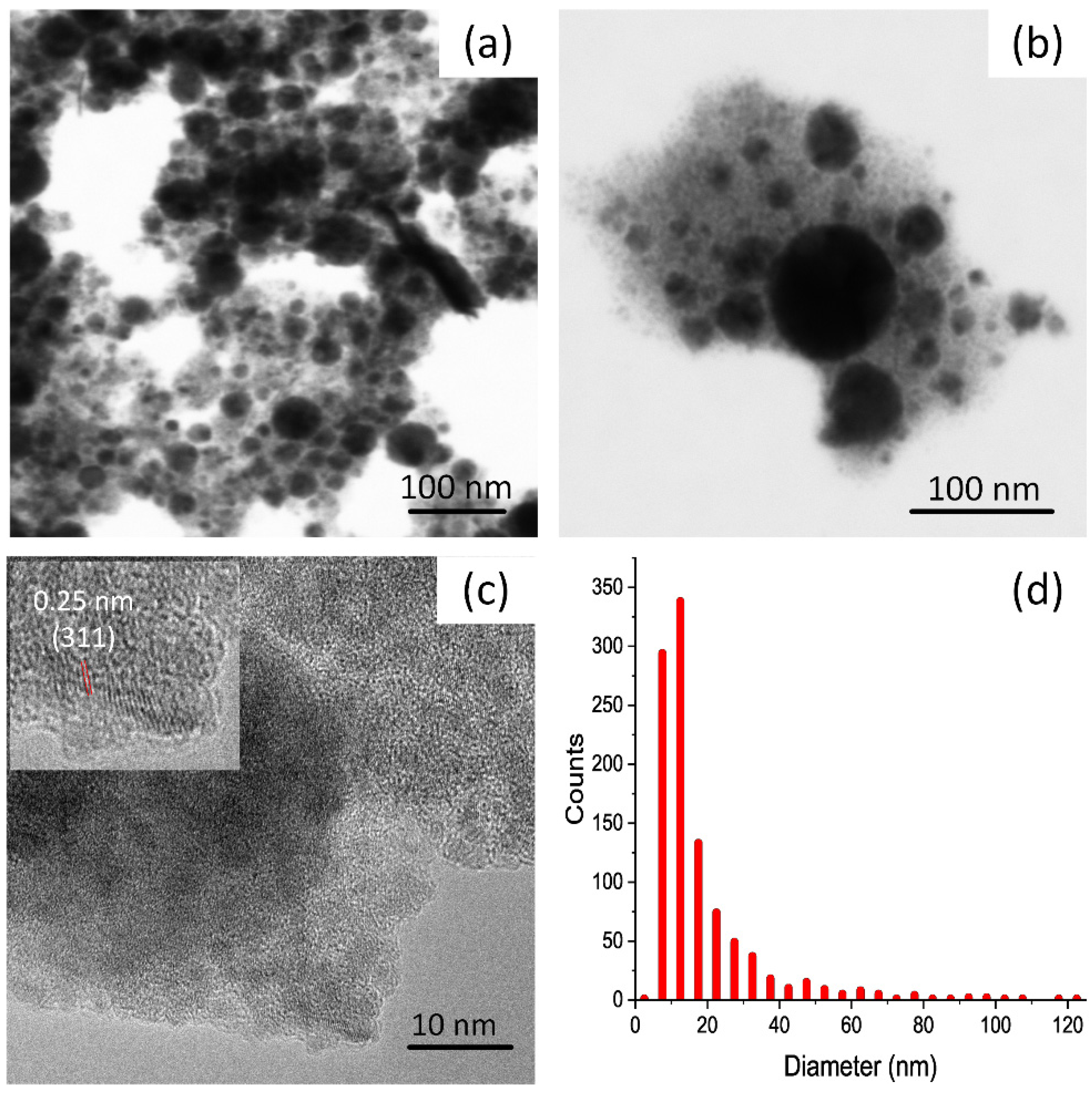
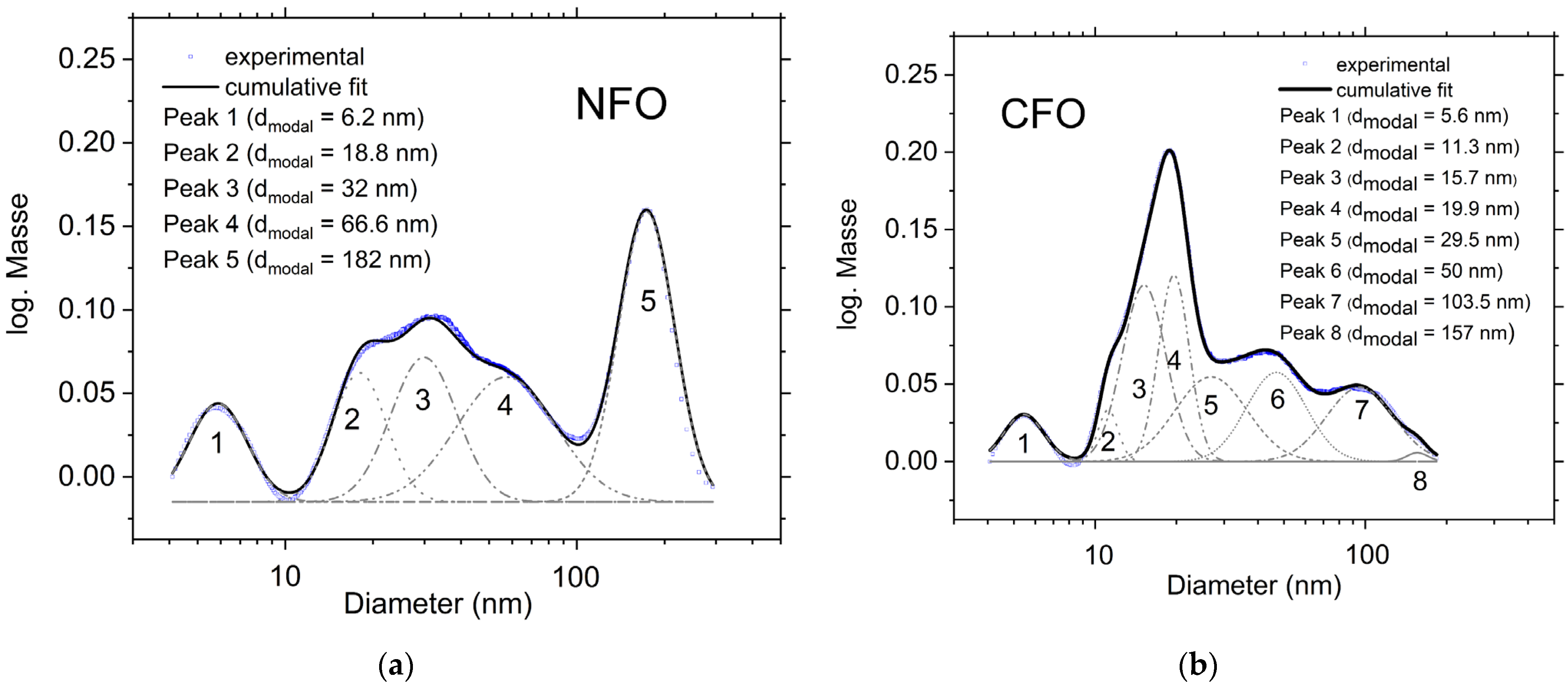
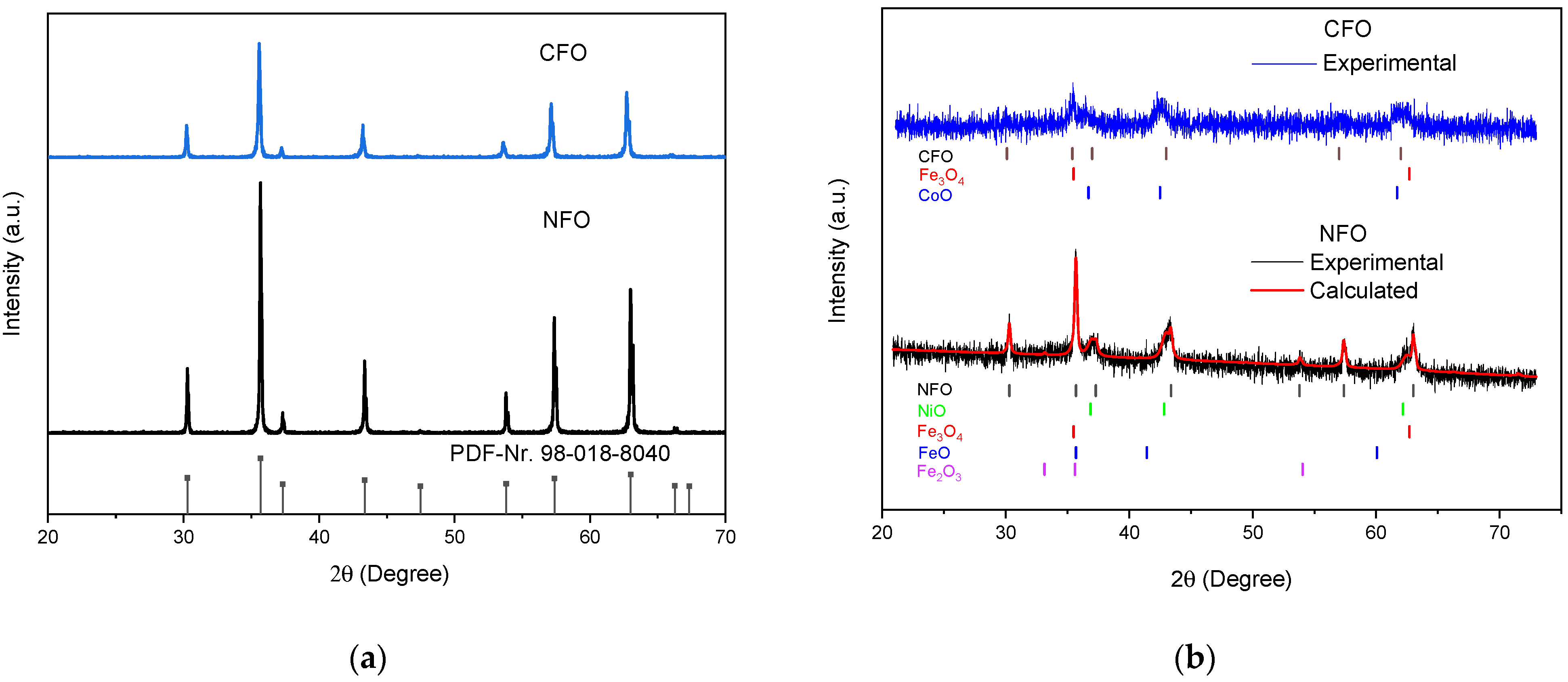

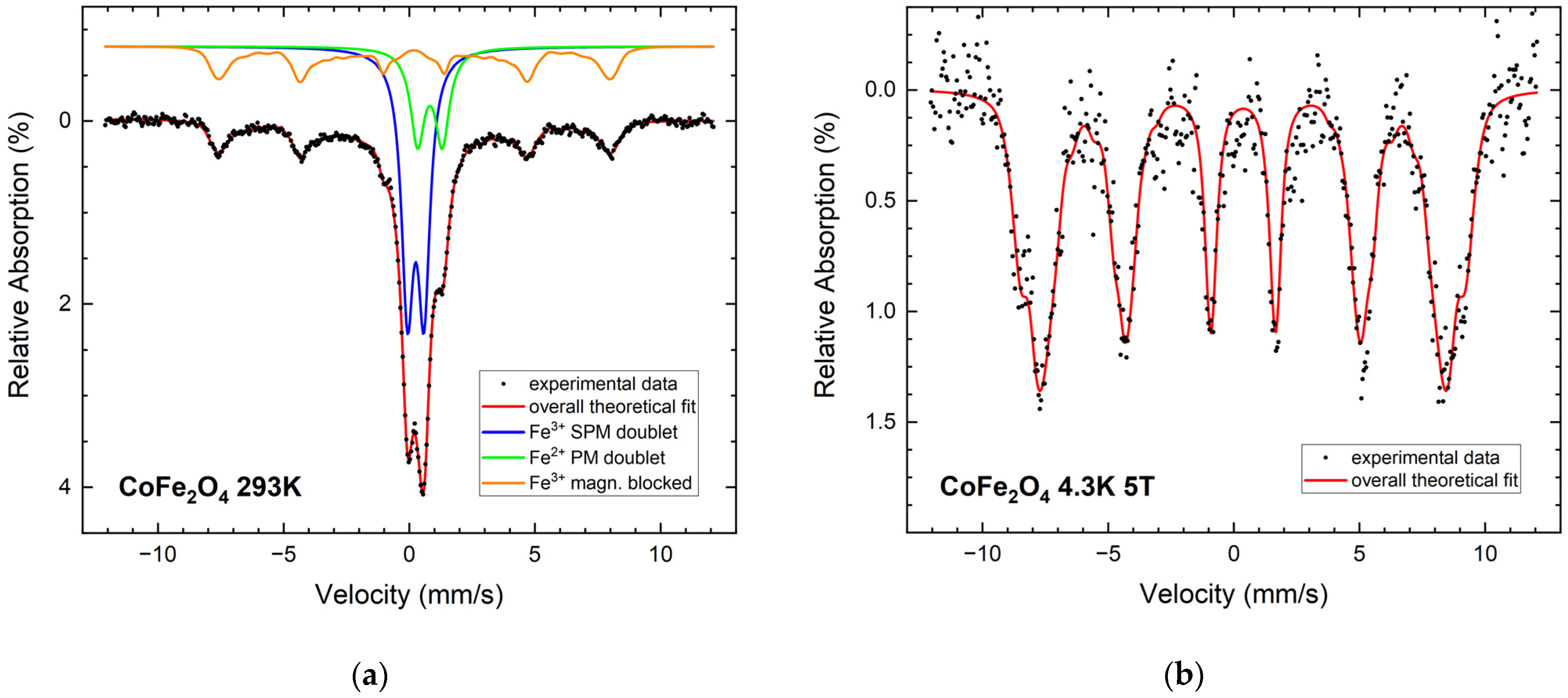

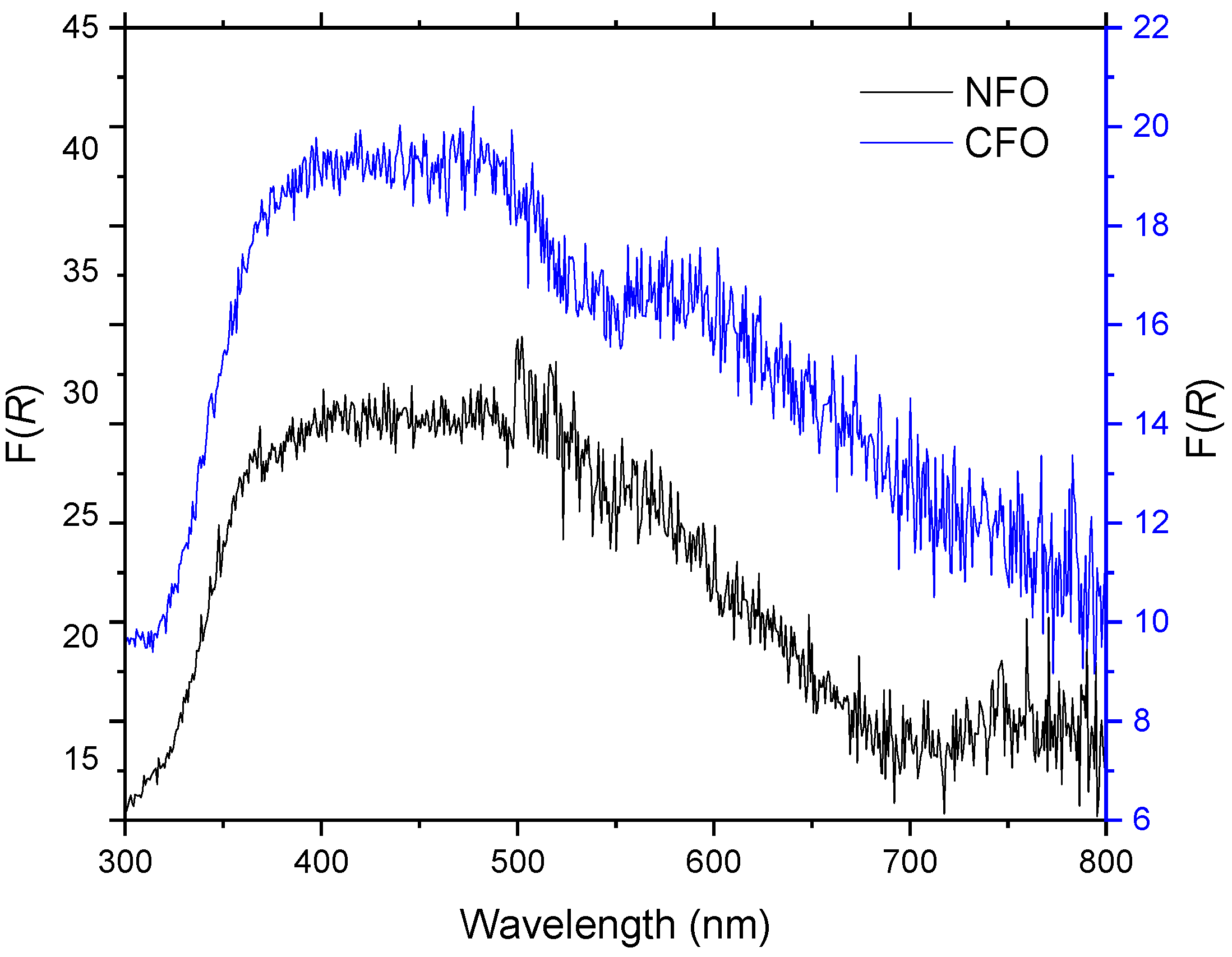
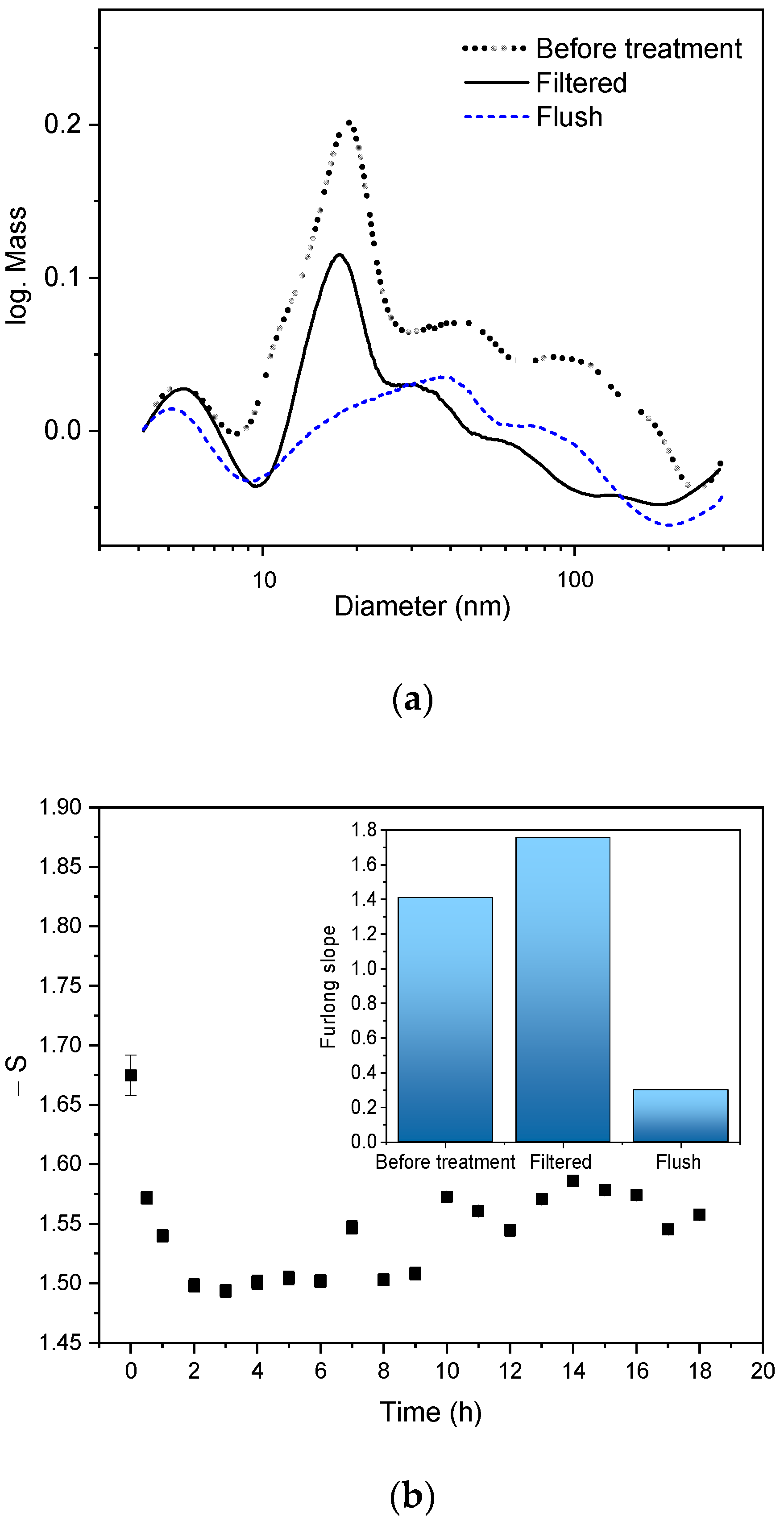
| Material | Density (g/cm3) | Mass Ablation (g) | Concentration (mg/L) | Ablation Rate (mg/min) |
|---|---|---|---|---|
| NiFe2O4 (NFO) | 5.19 | 0.0679 | 32.33 | 1.29 |
| CoFe2O4 (CFO) | 4.72 | 0.0591 | 28.14 | 1.13 |
| Sample | Hc (4 K) (mT) | Hc (300 K) (mT) | Mr (4 K) (Am2/kg) | Mr (300 K) (Am2/kg) | Mmax (4 K) (Am2/kg) | Mmax (300 K) (Am2/kg) |
|---|---|---|---|---|---|---|
| NFO bulk | 2.23 | 0.07 | 1.0 | 0.03 | 52 | 48 |
| NFO NPs | 63.0 | 34.5 | 7.57 | 5.65 | 28 | 21 |
| CFO bulk | 174.3 | 17.13 | 46.84 | 6.63 | 90 | 81 |
| CFO NPs | 719.35 | 114.96 | 9.66 | 3.77 | 28 | 23 |
Publisher’s Note: MDPI stays neutral with regard to jurisdictional claims in published maps and institutional affiliations. |
© 2022 by the authors. Licensee MDPI, Basel, Switzerland. This article is an open access article distributed under the terms and conditions of the Creative Commons Attribution (CC BY) license (https://creativecommons.org/licenses/by/4.0/).
Share and Cite
Sachse, E.; Escobar-Castillo, M.; Waag, F.; Gökce, B.; Salamon, S.; Landers, J.; Wende, H.; Lupascu, D.C. Laser Ablation of NiFe2O4 and CoFe2O4 Nanoparticles. Nanomaterials 2022, 12, 1872. https://doi.org/10.3390/nano12111872
Sachse E, Escobar-Castillo M, Waag F, Gökce B, Salamon S, Landers J, Wende H, Lupascu DC. Laser Ablation of NiFe2O4 and CoFe2O4 Nanoparticles. Nanomaterials. 2022; 12(11):1872. https://doi.org/10.3390/nano12111872
Chicago/Turabian StyleSachse, Erik, Marianela Escobar-Castillo, Friedrich Waag, Bilal Gökce, Soma Salamon, Joachim Landers, Heiko Wende, and Doru C. Lupascu. 2022. "Laser Ablation of NiFe2O4 and CoFe2O4 Nanoparticles" Nanomaterials 12, no. 11: 1872. https://doi.org/10.3390/nano12111872







